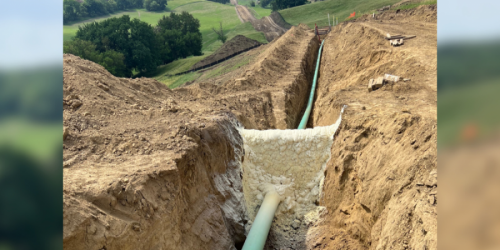Q&A Forums
Concrete Slab - Plastic Vapor barrier required? Post New Topic | Post Reply
| Author | Comments |
|---|---|
|
marc camm
Posted: Dec 21, 2013 05:20 AM
|
Concrete Slab - Plastic Vapor barrier required?
I live in New England and my contractor is currently renovating my attached garage to convert it into living space. The floor of the garage is a concrete slab. There is currently a small step down between the level of floor of the house and the slab of the garage. He plans to put joists across the slab to raise the level so when he puts in a floor it will be at the same level as the floor of the rest of the house. He was going to put down a vapor barrier and then use batt insulation to get R30 in the floor however the is not enough depth between the new floor and the slab to put in batt insulation. He is now planning to use spray foam. My question is if he uses spray foam does he still need to put down a plastic vapor barrier or is that no longer required since he is using spray foam?I would appreciate your guidance. |
|
jimcoler
I have over 10 years of experience specifying and installing open and closed cell spray foam. I've sold my business but I'm still selling for the new owners and consulting on large and custom specific jobs. I've expanded my knowledge into t Posted: Dec 21, 2013 09:22 AM
|
I would still use the vapor barrier and even possibly Low-E Reflective insulation before putting down the spray foam. You see you want to stop the moisture from entering the home and it's trying to enter through the ground up through the floor. So, a vapor barrier on the bottom side is where you want this to be. Like I said, the better solution is to put Low-E reflective insulation across the bottom of the floor which will act as a vapor barrier and a thermal break. Then you can use 6" of open or 3-4" of closed cell spray foam. The other option is to keep the floor joists up off the concrete floor a little and then you can spray the floor with 3-4"closed cell spray foam which will suffice as your vapor barrier. |
|
marc camm
Posted: Dec 21, 2013 10:46 AM
|
Thanks for the reply. I appreciate it! So he should put a plastic vapor barrier on top of the cement slab then the joists and then it gets covered with spray foam, correct? Does anyone else have any thoughts on this? Thanks |
|
Mark Mouton
Posted: Dec 22, 2013 06:54 AM
|
Ask George Spanos (Sprayfoam Distributors of New England 855-895-5792). He's right there in your same climate. He could probably recomend a good sprayfoam installer also. You want some that knows what they're doing. |
|
marc camm
Posted: Dec 22, 2013 07:28 AM
|
Thanks. I will give him a call! Regards, |
|
John Shockney
Posted: Dec 22, 2013 08:54 PM
|
Well the first plan that your contractor had was wrong because it put the vapor barrier on the cold side of the system. VAPOR BARRIER IS ALLWAYS ON THE WARM SIDE OF THE INSULATION SYSTEM!!!!! 2nd you can’t spray foam onto plastic it won’t stick to it and it does some strange things that can create air pockets or voids. I would assume that the plan that your contractor now has is to use closed cell foam because you can get R-30 with 4.5-5 inches of closed cell foam and with closed cell you should just spray it directly to the concrete. I would leave an half inch or more gap between the joists and the concrete mostly to get the advantage of reducing thermal bridging and also a one piece monolithic foam insulation system. Thanks Airpro |
|
mason
Posted: Dec 23, 2013 02:56 PM
|
In this case I would use a low perm rated coating for a vapor barrier first then spray the foam. As said by others, foam doesn't stick well to poly sheets and it is not a secure substrate any way. check with your supplier for their recommended vapor retarder coating. We used to use an asphalt mastic (spray grade) when insulating slabs for cold storage applications. Very cheap, but takes a long time to dry and is quite stinky for a while. |
|
John Shockney
Posted: Dec 24, 2013 12:09 PM
|
Yes Mason in a cold storage application you would apply a vapor barrier down to the concrete before applying the foam, because then the vapor barrier would be on the warm side of the insulation system!! But in a home this would be wrong! If there is any air leakage through the insulation the warn moist air would hit the cold vapor barrier and condensate trapping the water in the insulation. One of the biggest concerns when converting a garage into living space is actually making sure run off water is diverted away! I can’t tell you how many times I have seen landscaping done after these projects that pushed water and dirt under these floors causing them to rot from the bottom. Make sure that you have proper drainage where the old garage door was. Airpro |
|
mason
Posted: Dec 25, 2013 03:13 PM
|
The ground typically contains a much higher moisture than the house and a vapor retarder should be placed to prevent moisture transfer from areas of high moisture content to areas of less moisture content. Check out SPFA's AY 118, Moisture Transmission paper. Moisture always travels from an area of high moisture content to an area of lower moisture content. Most of the time that would be the warm side but not always. Do the calculations to determine which side to place the vapor retarder. I agree most of the moisture problems I have seen in basement comes from not having a draining tile system at the foundation to drain water away from the house. |





























